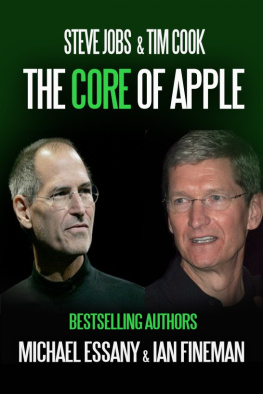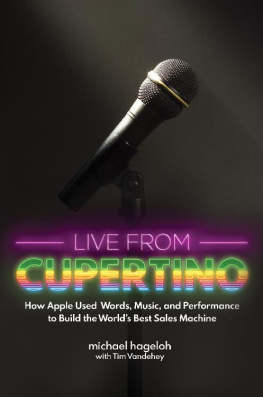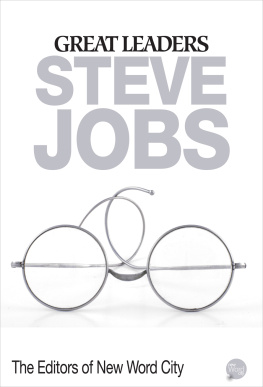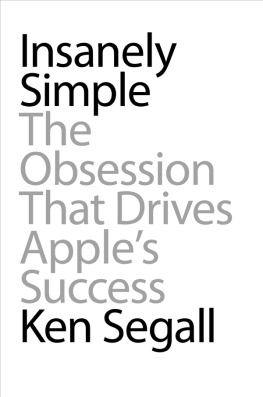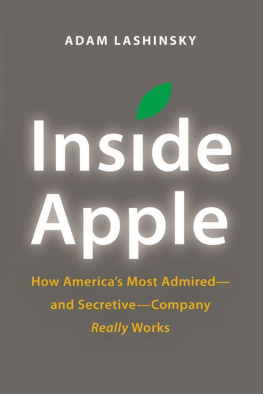Creative Selection
Inside Apples Design Process During the Golden Age of Steve Jobs
Ken Kocienda
St. Martins Press

New York
Thank you for buying this St. Martins Press ebook.
To receive special offers, bonus content, and info on new releases and other great reads, sign up for our newsletters.
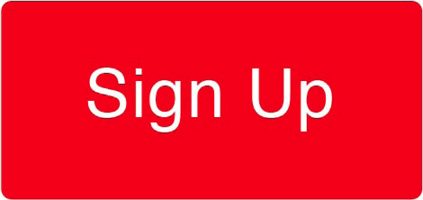
Or visit us online at us.macmillan.com/newslettersignup
For email updates on the author, click here.
The author and publisher have provided this e-book to you for your personal use only. You may not make this e-book publicly available in any way. Copyright infringement is against the law. If you believe the copy of this e-book you are reading infringes on the authors copyright, please notify the publisher at: us.macmillanusa.com/piracy .
For CDK and JGK
This book is about my fifteen years at Apple, my efforts to make great software while I was there, and the stories and observations I want to relate about those times. If you want to know what it was like to give a demo to Steve Jobs, or why the iPhone touchscreen keyboard turned out the way it did, or what made Apples product culture special, read on.
Ill tell you what it was like to be an Apple software engineer, the pressures and pleasures of working at such a demanding company, and the rush of excitement we coders feel when we make a computer do something new using nothing more than solitude, brain power, and typing.
Ill tell you about the Apple programmer community I became a part of, and how a small group of geeky introverts created a web browser and a touchscreen smartphone operating system starting with only dreams, goals, and ideas.
Ill tell you about how programmers fit into the larger Apple software development system, the joys of collaborating with designers who could bring refinement and elegance to the look and feel of our apps, and the stress of presenting work to colleagues, managers, and executives who always pressed for improvements that seemed just out of reach.
There are many aspects to making products in the Apple wayindustrial design, hardware engineering, marketing, legal, and managing a vast international supply chain, to name just a fewbut to understand what makes Apple what it is, its essence, you need to understand software, and Ill introduce you to the world programmers inhabit, how software gets made from scratch, and how we tried to imbue this software with spirit. While other companies design beautiful hardware, excel at marketing, hire good lawyers, and manufacture gadgets at scale, no other company makes software as intuitive, carefully crafted, or just plain fun. If theres a unique magic in Apples products, its in the software, and Ill tell you how we created some of the most important software in the companys history.
When I joined Apple in 2001, desktop and laptop computers were still the companys main products, and while the colorful iMac had been a notable success in reestablishing Apple as a design leader in high technologySteve Jobs had been back for four years following his eleven-year exilethe company still sat below 5 percent share in a market dominated by Microsoft Windows. Apple certainly had its core enthusiasts at that time, and they were passionate about its products, but to everyone else, the Mac was a computer they might have used in college but forgot about when they became adults and got jobs.
Four months after I started at Apple, things started to change. The release of the iPod was as much a surprise to me as it was to everyone else, and this portable music player kick-started Apples shift from computers to personal technology. The iPod also provided the money and the confidence that would lead to the development of the wildly successful devices that followed. This culminated with the iPhone, the product that transformed Apple from a technology bit player into one of the worlds most profitable enterprises.
I was a witness and a contributor to these times and these changes. I started programming for the iPhone when the number of software engineers and designers on the secretive project could fit in a small conference room. If you ask me about the first iPad, I might refer to it as K48, the internal code name we developers used before Steve Jobs and the marketing department picked a real product name. Today, on the day Im writing this introduction, hundreds of millions of people will use these Apple products, and if you count the browsers on Windows and Google Android that use code based on the Safari browser I helped develop, then the number of daily users runs to well over a billion, perhaps its closer to two.
Yet we never thought about such big numbers. We were too busy focusing on small details. Every day at Apple was like going to school, a design-focused, high-tech, product-creation university, an immersion program where the next exam was always around the corner. With that intensity came an insistence on doing things right, and, without explicitly trying to do so, we developed an approach to work that proved particularly effective for creating great software.
My goal is to share our approach with youto explain the way we worked. To begin this discussion, I have identified seven elements essential to Apples software success:
- Inspiration: Thinking big ideas and imagining what might be possible
- Collaboration: Working together well with other people and seeking to combine your complementary strengths
- Craft: Applying skill to achieve high-quality results and always striving to do better
- Diligence: Doing the necessary grunt work and never resorting to shortcuts or half measures
- Decisiveness: Making tough choices and refusing to delay or procrastinate
- Taste: Developing a refined sense of judgment and finding the balance that produces a pleasing and integrated whole
- Empathy: Trying to see the world from other peoples perspectives and creating work that fits into their lives and adapts to their needs
There werent any company handbooks describing these elements. Nobody outlined this list in a new-employee orientation. There werent any signs affixed to the walls of our Cupertino campus exhorting us to Collaborate! On the contrary, we felt, on an instinctive level, that imposing a fixed methodology might snuff out the innovation we were seeking. Therefore, our approach flowed from the work. This happened from the top down, stemming from the unquestioned authority and uncompromising vision of Steve Jobs, and it happened from the ground up, through the daily efforts of designers and programmers youve never heard of, people like me and my colleagues, some of whom Ill tell you about.
You may have come to this book for a number of reasons, among them to find a from-the-trenches perspective on how an iconic American company worked, to hear the back story on some of your favorite Apple products, or to learn something about the arcane craft of software development. But if youre expecting to read a handbook about the Seven Elements That Made Apple Great, I hope youll see that working in the Apple style is not a matter of following a checklist.
While the seven essential elements are a distillation of what we did on an everyday basis, they represent long-term discovery too. An important aspect of this book is the way we built our creative methods as a by-product of the work as we were doing it. As all of us pitched in to make our products, we developed our approach to creating great software. This was an evolution, an outgrowth of our deliberate attention to the task at hand while keeping our end goal in mind. We never waited around for brilliant flashes of insight that might solve problems in one swoop, and we had few actual Eureka! moments. Even in the two instances in my Apple career when I did experience a breakthroughmore about these laterthere certainly was no nude streaking across the Apple campus like Archimedes supposedly did. Instead, we moved forward, as a group, in stepwise fashion, from problem to design to demo to shipping product, taking each promising concept and trying to come up with ways to make it better. We mixed together our seven essential elements, and we formulated molecules out of them, like mixing inspiration and decisiveness to create initial prototypes, or by combining collaboration, craft, and taste to give detailed feedback to a teammate, or when we blended diligence and empathy in our constant effort to make software people could use without pulling their hair out. As we did all this mixing and combining of our seven essential elements, we always added in a personal touch, a little piece of ourselves, an octessence, and by putting together our goals and ideas and efforts and elements and molecules and personal touches, we formed our approach, an approach I call creative selection.



